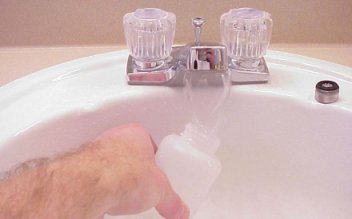|
How does lead get into tap water?
Typically, lead gets into your water after the water leaves your
local treatment plant or your well. That is, the source of lead
in your home's water is most likely pipe or solder in your home's
own plumbing. The most common cause is corrosion, a reaction between
the water and the lead pipes or solder. Dissolved oxygen, low pH
(acidity) and low mineral content in water are common causes of
corrosion. All kinds of water, however, may have high levels of
lead. See Lead in Your Drinking Water:
Actions You Can Take to Reduce Lead In Drinking Water.
Return to Top
What are the health effects of
lead in drinking water?
The health effects of lead are most severe for infants and children.
For infants and children, exposure to high levels of lead in drinking
water can result in delays in physical or mental development. For
adults, it can result in kidney problems or high blood pressure.
Although the main sources of exposure to lead are ingesting paint
chips and inhaling dust, EPA estimates that 10 to 20 percent of
human exposure to lead may come from lead in drinking water. Infants
who consume mostly mixed formula can receive 40 to 60 percent of
their exposure to lead from drinking water.See Lead
in Your Drinking Water: Actions You Can Take to Reduce Lead In Drinking
Water.
Return to Top
How can I reduce lead in drinking
water at home?
Flush your pipes before drinking, and only use cold water for consumption.
Anytime the water in a particular faucet has not been used for six
hours or longer, "flush" your cold-water pipes by running
the water until it becomes as cold as it will get. (This could take
as little as five to thirty seconds if there has been recent heavy
water use such as showering or toilet flushing. Otherwise, it could
take two minutes or longer.) The more time water has been sitting
in your home's pipes, the more lead it may contain.
Use only water from the cold-water tap for drinking, cooking, and
especially for making baby formula. Hot water is likely to contain
higher levels of lead. The two actions recommended above are very
important to the health of your family. They will probably be effective
in reducing lead levels because most of the lead in household water
usually comes from the plumbing in your house, not from the local
water supply. See Lead in Your Drinking
Water: Actions You Can Take to Reduce Lead In Drinking Water.
[2/26/04 NOTE: Longer
flushing times may be needed to respond to local conditions.]
Return to Top
How can I tell if my water contains
too much lead?
 You
should have your water tested for lead by a certified laboratory.
(Lists are available from your state or local drinking water authority).
Testing costs between $20 and $100. Since you cannot see, taste,
or smell lead dissolved in water, testing is the only sure way of
telling whether or not there are harmful quantities of lead in your
drinking water. You should be particularly suspicious if your home
has lead pipes (lead is a dull gray metal that is soft enough to
be easily scratched with a house key), if you see signs of corrosion
(frequent leaks, rust-colored water, stained dishes or laundry,
or if your non-plastic plumbing is less than five years old. Your
water supplier may have useful information, including whether or
not the service connector used in your home or area is made of lead.
Testing is especially important in high-rise buildings where flushing
might not work.See Lead in Your Drinking
Water: Actions You Can Take to Reduce Lead In Drinking Water. You
should have your water tested for lead by a certified laboratory.
(Lists are available from your state or local drinking water authority).
Testing costs between $20 and $100. Since you cannot see, taste,
or smell lead dissolved in water, testing is the only sure way of
telling whether or not there are harmful quantities of lead in your
drinking water. You should be particularly suspicious if your home
has lead pipes (lead is a dull gray metal that is soft enough to
be easily scratched with a house key), if you see signs of corrosion
(frequent leaks, rust-colored water, stained dishes or laundry,
or if your non-plastic plumbing is less than five years old. Your
water supplier may have useful information, including whether or
not the service connector used in your home or area is made of lead.
Testing is especially important in high-rise buildings where flushing
might not work.See Lead in Your Drinking
Water: Actions You Can Take to Reduce Lead In Drinking Water.
Return to Top
Should I be concerned about lead
in drinking water in my child's school or day care center?
Children spend a significant part of their days at school or in
a child care facility. The faucets that provide water used for consumption,
including drinking, cooking lunch, and preparing juice and infant
formula, should be tested. See Lead-free
Schools and Day Care Centers .Also see "Children
and Drinking Water Standards" and "Drinking Water and
Health: What You Need to Know".
Return to Top
What are the legal limits regarding
lead and drinking water?
Lead and copper are regulated by a treatment technique that requires
systems to control the corrosiveness of their water. If more than
10% of tap water samples exceed the action level of 15 parts per
billion, water systems must take additional steps to reduce corrosivity.
|

